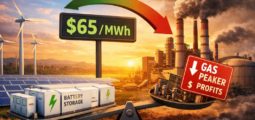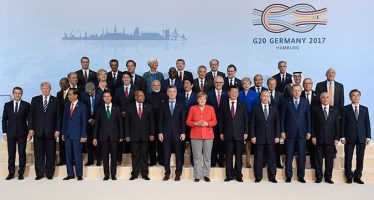European Environment Agency: EU 2050 – Green Economy Needs Fundamental Change
 The EU is largely on track to meet its climate change-related goals for 2020. While this is a considerable achievement, I believe there is a lot more to do. Most critically, the incremental gains we are currently achieving to meet such targets may not necessarily put us on track to long-term sustainability or a truly green economy, in line with Europe’s objectives for 2050.
The EU is largely on track to meet its climate change-related goals for 2020. While this is a considerable achievement, I believe there is a lot more to do. Most critically, the incremental gains we are currently achieving to meet such targets may not necessarily put us on track to long-term sustainability or a truly green economy, in line with Europe’s objectives for 2050.
Many of our existing environmental policy targets focus on incremental efficiency improvements within the current technological and economic paradigm. However, incremental efficiency gains are often offset by changes in human behaviour or by the rapid globalisation of unsustainable systems of production and consumption. The result is further environmental degradation. Efficiency gains alone are not enough to enable the transition to a green economy. Indeed, I will argue that we need a systemic shift in order to resolve many of our environmental problems in the long-term.
Bouncing Back
Incremental gains in efficiency – for example in car fuel efficiency or energy saving household appliances – are offset by changes elsewhere due to the rebound effect. This reduces the effect of efficiency gains, and means that the earth’s resources remain under pressure.
“Most critically, the incremental gains we are currently achieving to meet such targets may not necessarily put us on track to long-term sustainability or a truly green economy, in line with Europe’s objectives for 2050.”
The rebound effect can be easily seen as it applies to our use of energy. Europe’s economy now employs far less energy per unit of GDP – indicating improved energy efficiency. But economic growth has increased further with the end-result that energy consumption in the EU has not changed greatly since 1990. With 76% of primary energy demand in 2011 being met by the burning of fossil fuels, this continues to place enormous pressure on the planet.
The housing model prevalent in the EU offers another example. Contemporary homes are more energy efficient, but this gain is partly offset by the increased size of homes. It costs less to heat a square metre of housing, but we now have more square metres of housing to heat. As a result, overall fuel consumption still goes up. There are many other examples to cite – in our mobility systems, food systems, and so on. If we fail to take the rebound effect into consideration, our efforts will result in improvements that are too small and come too slow. These improvements also fail to address the more fundamental systemic challenges we face.
Beyond the Current Model of Development
The rebound effect is an example of how the current model of development – based on unsustainable levels of production and consumption – is harming the environment.
The current development model did, however, register a few successes as evidenced by our collective effort to improve the lives of the world’s poorest people. The proportion of people living in extreme poverty has been halved globally, while the hunger reduction target of the Millennium Development Goals is within reach. Since 1990, over two billion people have gained access to safe sources of drinking water, and the proportion of slum dwellers in the metropolises of the developing world is declining.
The global middle class is set to expand dramatically over the coming decades. According to the OECD (Organisation for Economic Cooperation and Development), this demographic will increase from 27% of the world population of 6.8 billion in 2009, to 58% of a predicted world population of 8.4 billion by 2030. Such a development will clearly have profound implications for the environment: Middle-class consumption patterns are typically resource-intensive and as such contribute to environmental pressures.
We should see this within the context of a planet which is already being overburdened by the demands placed on it. Most people on earth still live within the boundaries of what the planet can tolerate – but they live poorly. Many others live in material comfort, but do so beyond planetary boundaries. Our habits of consumption cannot be replicated by the rest of the world without huge environmental repercussions.
While improving the living standards of the poorest people is important, we must be careful that our development model does not simply move people from the category of living poorly within planetary boundaries to the category of those living well but beyond that what the earth can reasonably expected to support. Hence, the challenge is to guarantee a good quality of life for all citizens of this planet, yet to do so within the boundaries of our shared and finite ecosystem. This implies the need of a serious and fundamental rethink of the socio-economic development paradigm.
A Vision of the Green Economy
We urgently require a model of change that will allow us to live well within our environmental means. This is often referred to as a green economy – a model which aims not only for improved efficiency, but also for the maintenance of long-term ecosystem resilience and enhanced human well-being.
The EU already has a vision for Europe in 2050, based on three main elements:
- A society that limits the generation of carbon emissions.
- A circular economy in which resources are being efficiently used, preventing and minimising waste.
- A region that is engaged in the preservation of ecosystems within and beyond its borders, respecting planetary boundaries.
The third and last point is particularly important for providing essential ecosystem services, such as flood protection or the preservation of soil fertility, that people across the world depend on for their well-being and livelihoods.
The 2050 vision highlights the gap between the path we are currently on and the destination we need to reach. For example, our current trajectory will not be enough to successfully conclude the transition to a low-carbon economy. By 2050, we are projected to only have reduced our greenhouse gas emissions by 40%. We must do much more and reduce greenhouse gas emissions by at least 80%. This means fundamental systemic action needs to take place between 2020 and 2050.
So what does systemic change look like? Instead of incremental improvements to the efficiency of cars, we must make the transition to an entirely new system of mobility. Instead of making incremental improvements to the efficiency of housing, we must re-think our housing, urban design and planning models. In the same vein, we must re-orient our food production system so that it promotes human well-being and ensures the resilience of ecosystems.
Ideas like the circular economy may provide a useful focus. This implies limiting our use of natural resources, and strengthening efforts at continuous recycling. Europe is still very far from achieving its target of 50% recycling by 2020. We need to start valuing waste as a resource in order to avoid depleting the earth’s increasingly slim bounty.
Recent EEA (European Environment Agency) assessments show that European environmental policies appear to have had a clearer impact on improving resource efficiency than they did on maintaining ecosystem resilience. In this context, it may be useful to consider other kinds of green economy objectives and targets, which explicitly recognise the relationships between resource efficiency, ecosystem resilience and human well-being.
Managing the Transition
Unfortunately there is a vital gap in the knowledge needed for the implementation of a transitional agenda. We know a lot about managing incremental change, but we know far less about managing systemic change in socio-technical systems. However, there seem to be some promising ways with which to manage this transition.
The most basic one entails the creation of new targets: Europe has already set targets for 2020 and 2030. These mostly aim at improved efficiency. We also have a vision for 2050, but this needs to be fleshed out with concrete new targets for period spanning from 2030 to 2050.
Economic policies may help drive this transition. Removing environmentally harmful subsidies is a goal clearly articulated in the EU’s 7th Environment Action Programme (EAP) – the recently-approved plan that sets out the EU’s environmental objectives and priorities for the next seven years. This should be part of a broader push to adopt environmental fiscal reform, which aims to take the tax burden from labour and put it onto consumption. Such an initiative also presents a particularly attractive opportunity for those economies that have been hit by the European debt crisis.
Alongside these policies, we will need to continuously monitor progress. This also means improving the knowledge base and the systems we use to measure environmental phenomena.
Over the coming years, work at the EEA will continue to refine our knowledge of the world around us, to inform policy implementation and assess systemic challenges up to 2050. In this context, we will be monitoring and evaluating implementation of the 7th EAP.
If we are to successfully change the way our social, technical and economic systems work, we need new ways of thinking about old problems. The challenge is both daunting and exciting. At the EEA, transition will be a priority work area over the years to come.
About the Author
Prof. Hans Bruyninckx is an Executive Director, of the European Environment Agency.
You may have an interest in also reading…
AVEVA: Software is the Key to Sustainable Industries
Digital thinking and data-led operations will accelerate the drive to net-zero and a decade of action. By Peter Herweck, CEO
G20: Challenges in Shaping an Interconnected World
Expertly ducking a potentially traumatic Trump (hand)shake by shooting past the US president to his wife Melania, Polish first lady
CBI Says ‘Get Major Projects Moving to Protect the Recovery’
Ahead of the Wednesday June 26th spending round, the Confederation of British Industry reiterated its call for the Chancellor to



















































































